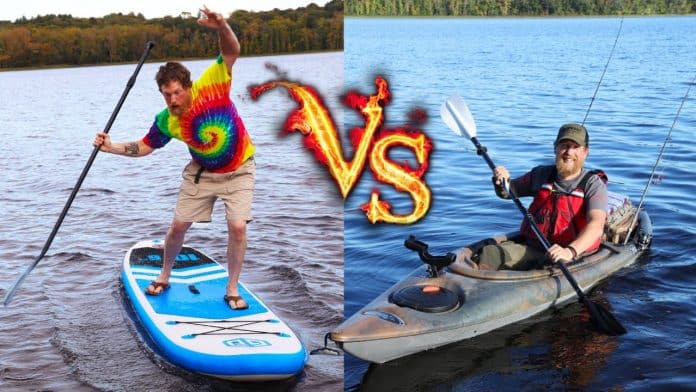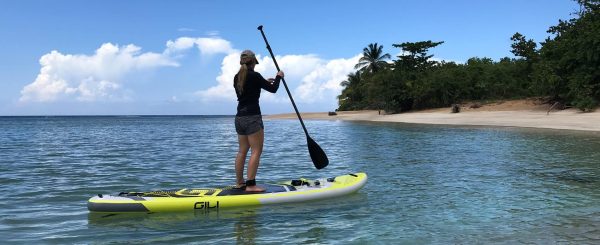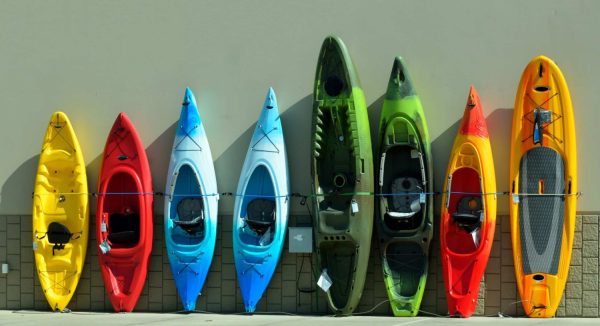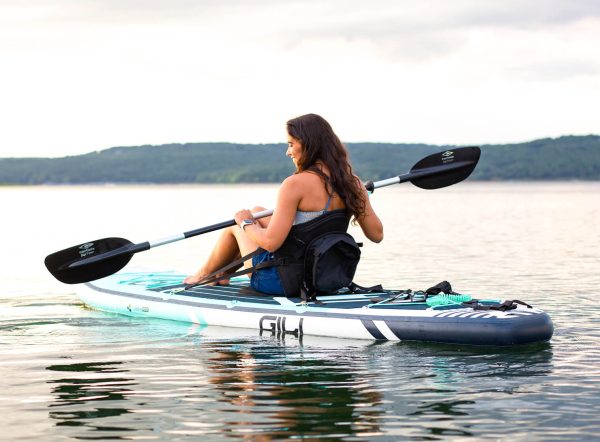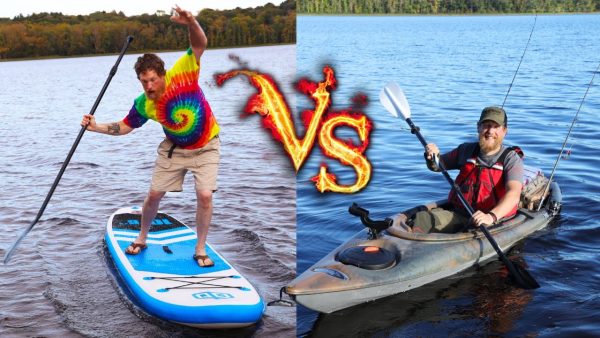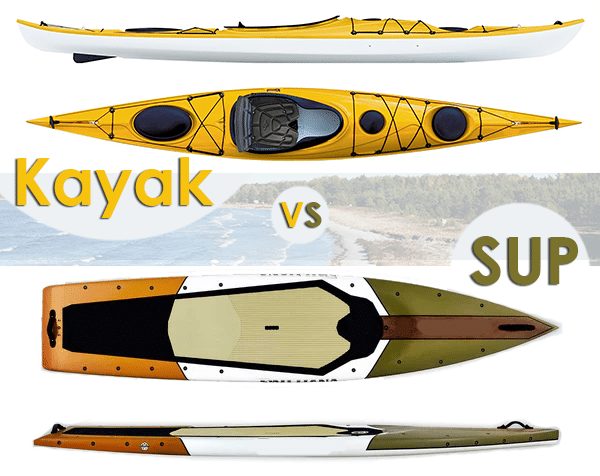Let’s begin a fun and insightful comparison between Stand-Up Paddleboarding (SUP) and kayaking.
We all love a thrilling adventure on the water, but which one is the more straightforward option?
In this article, we’ll explore both activities’ skills, techniques, and overall experience to uncover whether SUP truly takes the crown as the easier choice.
So, grab your paddles and join us as we navigate through this exciting exploration of SUP versus kayak!
This image is the property of www.gilisports.com.
What is SUP?
Stand-up paddleboarding, or SUP, is a water activity that involves standing on a giant surfboard and propelling oneself forward using a paddle. It offers a unique and enjoyable way to explore bodies of water, such as lakes, rivers, and even the ocean. SUP has gained significant popularity recently due to its accessibility, versatility, and numerous health benefits.
Definition of SUP
As the name suggests, SUP involves standing on a paddleboard and paddling through the water using a long paddle. Unlike traditional surfing, SUP doesn’t require catching waves and can be done in calm or choppy waters. It combines elements of surfing, kayaking, and even yoga, providing a full-body workout and an opportunity to connect with nature.
History of SUP
The roots of SUP can be traced back to ancient cultures, such as Polynesians, who used longboards and paddles for transportation and fishing. However, modern SUP as we know it today originated in Hawaii during the 20th century. Surf instructors used to stand on their surfboards with paddles to observe their students better. Over time, it evolved into a popular recreational activity, eventually spreading to the mainland United States, Europe, and beyond.
Different types of SUP boards
SUP boards come in various shapes and sizes to accommodate different water conditions and paddler preferences. The most common types include:
- All-Around SUPs: Versatile and suitable for beginners, these boards are designed for stability and easy maneuverability. They work well in various water conditions, from calm lakes to small waves.
- Touring SUPs: Longer and narrower than all-around SUPs, touring boards are built for speed and long-distance paddling. They have a more streamlined shape, making them ideal for exploring lakes, rivers, and coastlines.
- Inflatable SUPs: Made from durable PVC material, inflatable SUPs offer convenience and portability. They can be easily deflated and rolled up for transportation and storage, making them a popular choice for travelers or those with limited storage space.
- Surf SUPs: Designed for more advanced paddlers and surfing enthusiasts, surf SUPs are shorter and narrower, with a pointed nose and a rocker shape. They allow for tight turns and maneuverability in waves.
What is Kayak?
A kayak is a small, narrow watercraft propelled using a double-bladed paddle. It originated from indigenous cultures, primarily in the Arctic regions, where it was used for hunting, fishing, and transportation in icy waters. Today, kayaking has evolved into a popular recreational activity, encompassing various types of kayaks and styles of paddling.
Definition of Kayak
A kayak is a small, narrow boat with a covered deck and a cockpit where the paddler sits. It is propelled by a double-bladed paddle, with one blade on each end. Kayaks come in different designs, each suited for specific water conditions and paddler preferences.
History of Kayak
The history of kayaking dates back thousands of years. Indigenous cultures, such as the Inuit and Aleut people, used kayaks for transportation and hunting in ice-covered waters. These early kayaks were typically made from animal skins stretched over a wooden or bone frame. As time passed, kayaking became a popular sport and recreational activity, spreading to other parts of the world and evolving into various forms and styles.
Different types of Kayaks
There are several types of kayaks, each designed to excel in different environments and activities. Some common types include:
- Recreational Kayaks: These kayaks are great for beginners and casual paddlers. They offer stability and ease of maneuverability and are typically broader and more spacious for added comfort.
- Sea Kayaks: Sea kayaks are designed for longer trips and open-water adventures. They are longer and narrower than recreational kayaks, allowing for increased speed, better tracking, and improved efficiency over long distances.
- Whitewater Kayaks: Built to withstand the rigors of fast-moving rivers and rapids, whitewater kayaks are shorter and more maneuverable. They have specialized features like rocker profiles, planing hulls, and grab handles for easy control and quick turns.
- Fishing Kayaks: Explicitly designed for anglers, fishing kayaks offer stability, comfort, and plenty of storage options for fishing gear. They often have features like rod holders, gear tracks, and even motor mounts.
Physical Demands
Engaging in SUP or kayaking requires specific physical demands, contributing to the overall health benefits of these water activities. Both sports engage various muscle groups and improve overall strength and endurance.
Balance
Balance is crucial in both SUP and kayaking. Maintaining stability requires core strength and focus when standing on a SUP board. Balancing on a kayak also requires core stability, as the narrow hull can be less forgiving than a paddleboard. Regular practice in both activities can enhance balance and proprioception.
Core Strength
SUP and kayaking engage the core muscles vital for stability and balance. In SUP, the core is used to maintain an upright position while paddling. In kayaking, the rotational movements of paddling engage the core muscles, strengthening them over time. Regular participation in either activity can lead to improved core strength and stability.
Upper Body Strength
Both SUP and kayaking involve upper body movements for propulsion. When paddling, the arms, shoulders, and back muscles are engaged, providing an excellent workout for the upper body. The repetitive motions of paddling can lead to increased strength and endurance in the upper body muscles.
Leg Strength
While SUP primarily engages the upper body and core muscles, kayaking requires using the legs for stability and control. The lower body, including the legs and hips, is actively involved in maintaining balance, especially in whitewater kayaking. Regular kayaking can improve leg strength and stability, benefiting overall lower-body fitness.
Skills Required
Engaging in SUP or kayaking requires developing specific skills to ensure safety, efficiency, and an enjoyable experience on the water. While some skills are specific to each activity, there are also areas of overlap.
Paddling Technique
Mastering proper paddling techniques is essential in both SUP and kayaking. In SUP, the paddle generates forward propulsion and steers the board. A correct paddle stroke involves a combination of arm, shoulder, and torso movements, utilizing the body’s larger muscle groups.
In kayaking, the double-bladed paddle is used to propel the boat forward. An efficient paddle stroke involves proper placement of the blades in the water, engaging the core and torso rotation to generate power. Both activities benefit from learning and refining proper paddling techniques to maximize efficiency and reduce the risk of injury.
Balancing Technique
Maintaining balance is crucial in both SUP and kayaking. In SUP, beginners learn techniques such as spreading their feet shoulder-width apart, maintaining a low center of gravity, and using their paddle as an additional balancing tool. Proper balance is achieved in kayaking by adjusting body weight and using the kayak’s primary stability.
Navigational Skills
Both SUP and kayaking require basic navigational skills to ensure safety and enjoyment on the water. Understanding water currents, wind patterns, and navigation aids are essential. Knowledge of marine rules and regulations, including right-of-way rules, is necessary for paddling shared waterways.
Rescue Skills
Being prepared for unexpected situations is vital in water activities. Both SUP and kayaking require knowledge of rescue techniques and self-rescue strategies. Understanding how to re-enter a kayak or climb back onto a SUP board after falling off is essential for maintaining safety and confidence on the water.
This image is the property of virginiawatertrails.org.
Stability
Stability plays a significant role in choosing between SUP and kayaking, affecting performance and comfort on the water.
SUP Stability
Thanks to their vast and long platform, SUP boards are generally more stable than kayaks. This stability makes SUP an excellent choice for beginners and those who prefer a relaxed, leisurely experience on calm water. The wider surface area of a SUP board allows paddlers to maintain a steady balance, making it suitable for activities such as yoga or fishing.
Kayak Stability
Kayaks come in various designs, each offering different levels of stability. Recreational kayaks are typically more stable due to their wider hulls, making them a good option for beginners. However, kayaks designed for whitewater or performance-oriented activities may sacrifice some stability for increased maneuverability and speed.
Factors Affecting Stability
Numerous factors can affect stability in both SUP and kayaking. The width and shape of the board or kayak play a significant role, with more comprehensive options offering more stability. Additionally, body weight, skill level, and water conditions can influence stability. Beginners or those seeking a more relaxed experience should prioritize stability when choosing between SUP and kayaking.
Ease of Learning
For beginners, the ease of learning can significantly influence the choice between SUP and kayaking. The learning curve can vary, and both activities require initial effort and practice.
SUP Learning Process
One of the advantages of SUP is its relatively gentle learning curve. Most beginners can quickly find their balance and paddle effectively within a short time. The stable platform and wide surface area of SUP boards provide a forgiving learning environment, making it accessible even to those with little to no prior experience. However, mastering more advanced techniques, such as paddling in challenging conditions or performing tricks, may require further practice and skill development.
Kayak Learning Process
Kayaking typically has a steeper learning curve than SUP, especially for beginners without prior experience. The narrower profile and lower initial stability of kayaks can pose initial challenges for first-time users. Learning to control the kayak and develop proper paddling techniques can take more time and practice. However, beginners can quickly progress and gain confidence on the water with proper instruction and guidance.
Common Challenges for Beginners
Both SUP and kayaking have their unique challenges for beginners. Common challenges include maintaining balance, learning proper paddling techniques, and adjusting to the water environment. Beginners must start in calm, controlled waters and seek instruction or guidance to overcome these initial obstacles.
This image is the property of cdn.shopify.com.
Versatility
The versatility of both SUP and kayaking is one of their key attractions. These activities allow for exploring various environments and engaging in different recreational pursuits.
SUP Versatility
SUP boards are incredibly versatile, allowing paddlers to enjoy various activities. From leisurely paddles on calm lakes to challenging waves in the ocean, SUP provides an accessible and adaptable experience. Additionally, SUP can be combined with other activities, such as yoga, fishing, or paddleboard surfing, further expanding the possibilities.
Kayak Versatility
Kayaks also offer versatility regarding the environments they can navigate and the activities they support. Sea kayaking allows exploring coastlines, archipelagos, and remote areas. Whitewater kayaking allows paddlers to traverse fast-moving rivers and enjoy the thrill of rapids. Fishing kayaks are designed with features and accessories specifically for anglers, while recreational kayaks can be used for a range of casual water activities.
Different Environments and Activities
Whether serene lakes, calm rivers, open oceans, or whitewater rapids, SUP and kayaking allow exploring diverse environments. Each activity offers unique opportunities for connecting with nature, spotting wildlife, and experiencing the beauty of different landscapes. Additionally, SUP and kayaking can be enjoyed as a solitary pursuit or as a social activity with friends and family.
Portability
The portability of equipment is a significant consideration for many water enthusiasts, especially those who travel or have limited storage space.
SUP Portability
One of the advantages of SUP is its portability, particularly with inflatable SUP boards. Inflatable SUPs can be deflated and rolled up into a compact size, making them easy to transport in a backpack or a small vehicle. Traditional hardboards are bulkier and may require specialized or roof racks for transportation. However, they can still be loaded onto a car or stored in a garage or shed when not in use.
Kayak Portability
Kayaks, especially rigid ones, tend to be less portable than SUP boards, primarily due to their larger size and weight. They often require roof racks or kayak trailers for transportation, which may limit the types of vehicles that can accommodate them. However, inflatable kayaks are a portable option that can be deflated and packed into a backpack or duffel bag. This makes them ideal for travel and storage in small spaces.
Transportation and Storage Considerations
Transporting and storing SUP boards and kayaks requires careful consideration. When transporting, secure the equipment properly to prevent damage or accidents. When not in use, storing them in a dry and secure location is essential to prolong their lifespan. Inflatable options offer the advantage of being easily stored in a closet or under a bed, while hardboards and rigid kayaks may require dedicated storage space.
This image is the property of i.ytimg.com.
Cost
The costs associated with SUP and kayaking can vary depending on factors such as the type of equipment, quality, and additional accessories required.
SUP Costs
The cost of a SUP board can vary depending on the type, size, and materials used. In general, inflatable SUPs are more affordable compared to hardboards. Prices range from around $300 for entry-level inflatable SUPs to over $2,000 for high-performance hardboards. Additional expenses may include paddles, life jackets, leashes, and other accessories.
Kayak Costs
Kayak costs vary depending on the design, material and intended use. Recreational kayaks are generally more affordable, ranging from $300 to $800. Sea kayaks and performance-oriented kayaks can cost anywhere from $800 to $2,500. Additional expenses may include paddles, life jackets, sprayskirts, and other specialized gear.
Additional Equipment and Maintenance
Both SUP boards and kayaks require additional equipment and maintenance. Paddles, life jackets, and appropriate clothing are essential for safety and comfort. Regular maintenance, such as cleaning, storage, and occasional repairs, may be necessary to ensure the longevity of the equipment. Considering these costs when considering SUP or kayaking as a recreational activity is essential.
Conclusion
In comparing SUP and kayaking, personal preference and skill level play a significant role. SUP offers a more stable and forgiving platform, making it easier for beginners to get started. It provides a great full-body workout and allows for diverse activities such as yoga or fishing. On the other hand, kayaking offers a more versatile range of water environments and activities, from sea kayaking to whitewater adventures. It may require more initial effort and practice to master, but it offers a rewarding and exhilarating experience on the water.
Ultimately, the choice between SUP and kayaking boils down to individual preferences, physical abilities, and the desired experience. Both activities offer unique benefits and opportunities for connection with nature. Whether gliding across calm lakes on a paddleboard or navigating rapids in a kayak, each option promises adventure, enjoyment, and a chance to explore the world from a different perspective.
This image is the property of nulltuul.com.

